Online Streaming Available April 17 – May 9, 2021
The FSO is proud to present a Concert of Healing & Hope, a virtual concert to honor the more than 500,000 people who have died during the pandemic and look forward with hope to better days ahead.
Online Streaming Available April 17 – May 9, 2021
The FSO is proud to present a Concert of Healing & Hope, a virtual concert to honor the more than 500,000 people who have died during the pandemic and look forward with hope to better days ahead.
Tickets will be $25 for unlimited viewing on a single device.
For multi-device viewing you will need to purchase additional tickets for each device.
If you want to gift tickets to someone else, please contact Larry Lang at llang@flagstaffsymphony.org
We hope you enjoy “Serenade for Strings.” As we continue to produce virtual programs until it is safe to come together again for a live performance, we sincerely appreciate your support for these online performances. Please share this program with your family and friends, and consider giving an extra donation through our Keep the Music Alive campaign. Thank you!
Violin 1
Shelley Rich, Concertmaster
Rachel Butherus, Assistant Concertmaster
Vanessa Miller, Jennifer Thomas Sponsored Chair
Kylie Ahern
Violin 2
Karin Hallberg, Principal
Allison Parks
Kin Siu
Sara May Wilbur, Maggie Vallejos and Peter Gibson Sponsored Chair
Viola
Jacquelyn Schwandt, Principal
Kim Sullivan, Cheri and Jay Ossenfort Sponsored Chair
Cindy Stewart Binkley, Roger and Lynn Perkins Sponsored Chair
David Koerner
Cello
Mary Anne Bruner, Principal, Molly and Gene Munger Sponsored Chair
Donna Natseway
Mary Nebel, Jude Mack Sponsored Chair
Travis Brown
Bass
Jason Roederer, Principal
Jason Baxter
Flute
Jeannette Moore, Principal, Purl in the Pines Sponsored Chair
Andrea Graves, Phyllis and Sam Wolfskill Sponsored Chair
Oboe
Rebecca Kemper Scarnati, Principal/ Michael and Karen Kitt Endowed Chair
Ruth Solin
Clarinet
Jon Eder, Principal, Anonymous Sponsored Chair
Mary Jackson
Bassoon – 2
Douglas Brown, Principal
David Bruner
Horn
Nancy Sullivan, Principal, Roger and Donna Muhlenkamp Sponsored Chair
Athena Blue
Conductor
Charles Latshaw
Guest Conductor
Edith A. Copley
Choir
The Shrine of the Ages Choir
Piano
Rita Borden
Stage Manager
Janice Gary
CORO ZAFFIRO (Blue Choir)
“i thank you god for most this amazing day” by Dan Forrest
text by e. e. cummings
Edith Copley, Conductor
Sopranos
Kayla Ewers
Allison Harmon
Sarah Irvin
Samantha Jorgensen
Sarah Raff
Kirsi Steverson
Altos
Kaylee Berry
Jeanette Evins
Anna Holt
Osanah Manzo
Mackenzie Nelson
Litzy Rosas
Tenors
Evan Braun
Tyrese Childs
Jesus Galaviz-Arreguin
Brian Robles
Shawn Romo
Basses
Jesus Aguirre
Patrick Bittner
Kazin Cole
Javi Roderguez
CORO ORO (Gold Choir)
“Agnus Dei” and “In Paradisum” from the Fauré Requiem
Charles Latshaw, conductor
Sopranos
Mattison Avery
Heather Drusedum
Amanda Everson
Esther Evins
Kara Palermo
Talia Ruiz
Hannah Van Belle
Altos
Anne Anderson
Abby Dotts
Matti Goldstein
Elizabeth Good
Amanda Johnson
Brooke Wochner
Roomie Wood
Tenors
Andrez Alcazar
Sean Gallegos
Sebastian Garcia-Valle
Alex Kaus
Desmond O’Connell
Basses
Carter Brown
Clayton D’Angelo
DeClan Formichella
Colton Stuart
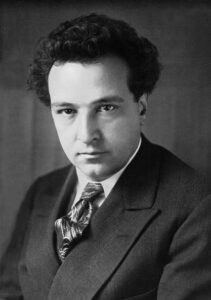 Arthur Honegger (1892-1955)
Arthur Honegger (1892-1955)
Pastorale d’ete (Summer Pastoral) (1920)
Arthur Honegger, a Swiss composer, was born in France and spent most of his working life in Paris. He studied music at the Zurich Conservatory and the Paris Conservatoire with Charles-Marie Widor and Vincent d’Indy (whose Chanson et Danses the FSO performed in February.)
Honegger’s most famous orchestral work, Pacific 231, is often studied by current music students as an example of orchestration with an enormous ensemble used to mimic a locomotive’s real-life sounds. But the Pastorale d’ete is Honegger’s first orchestral piece, written for a much smaller collection of instruments, and shows an equal level of orchestrational imagination and beauty. It was composed in 1920 while Honegger was vacationing in the swiss alps in Wengen, near Bern. Most scholars believe Pastorale d’ete (Summer Pastoral) to be an impressionistic depiction of a peaceful summer morning in the alps. One can hear a gentle rising of the sun depicted in the strings, along with the chirping of birds. Honegger also pays homage to Beethoven, writing a little melody in the clarinet, which is an inversion of Beethoven’s melody from the beginning of his 6th symphony, the “Pastoral.”
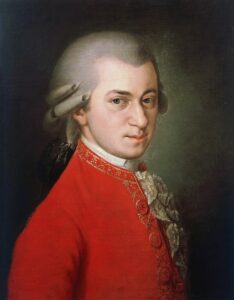 Wolfgang Mozart (1756-1791)
Wolfgang Mozart (1756-1791)
Piano Concerto No. 21 in C major, K. 467, Movement II (1785)
Wolfgang Amadeus Mozart composed more piano concertos than any of his contemporaries, mainly because he often performed them himself in concerts in Vienna. The 21st piano concerto was composed at a busy time in Mozart’s life. He had just written to his father that he had performed twenty-two concerts in only thirty-eight days. His piano was constantly being moved from his home to various venues around the city, so Mozart had very little time to practice and was often writing concertos during the day that he would perform in the evening. At the premiere of the 21st concerto, Mozart’s copyist was still writing out the parts for the last movement while the orchestra was rehearsing the first two, and the finale had to be performed without any rehearsal while the ink hadn’t yet dried.
The 21st concerto was famously used in a 1967 Swedish film, Elvira Madigan, and is occasionally referred to as the “Elvira Madigan Concerto.” The second movement played in this program is one of Mozart’s most beautiful and peaceful compositions.
Rita Borden has distinguished herself as a versatile collaborative pianist performing orchestral, vocal, and chamber music concerts throughout the country. She has appeared on the Chamber Music Sedona series and has performed with the San Diego Symphony and Master Chorale, Pacific Symphony and is principal keyboardist with Flagstaff Symphony Orchestra. Ms. Borden joined the Northern Arizona University-School of Music faculty in 1995 where she teaches piano, accompanying and chamber music. She is an active performer on campus with faculty and guest artists and for several years was the coordinator of the Faculty Chamber Music Series. Ms. Borden earned a Bachelor of Music Education from the University of Northern Colorado and a Master of Music in Accompanying from the University of Southern California where she studied with Gwendolyn Koldofsky, Brooks Smith and Malcolm Hamilton.
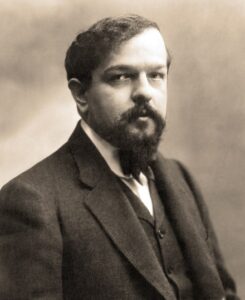 Claude Debussy (1862-1918)
Claude Debussy (1862-1918)
Clair de Lune (Moonlight), Movement III from Suite Bergamasque (1905)
orchestrated by André Caplet
Claude Debussy’s most famous piece, “Clair de Lune,” is the third movement from his larger piece for solo piano, the Suite Bergamasque. A bergamasque was a rustic 17th-century dance from Italy, named for the town of Bergamo. While the bergamasque was no longer a popular dance, it had been referenced in some literary works, including Shakespeare’s Midsummer Night’s Dream and, apropos of this piece, in Paul Verlaine’s poem “Clair de lune.”
Your soul is like a landscape fantasy,
Where masks and bergamasks, in charming wise,
Strum lutes and dance, just a bit sad to be
Hidden beneath their fanciful disguise.
Debussy’s piano piece takes its title from Verlaine’s poem but does not mimic the original musical traditions of a bergamasque dance form. Instead, it’s a gentle reflection on the idea of moonlight. Debussy hated the term “impressionism” to describe his music, but it absolutely applies here as the piece gives such a lovely impression of a quiet evening under the moon.
This FSO performance features an orchestration of the piano piece done by André Caplet, a close friend of Debussy’s who orchestrated several of Debussy’s works with the composer’s permission and supervision.
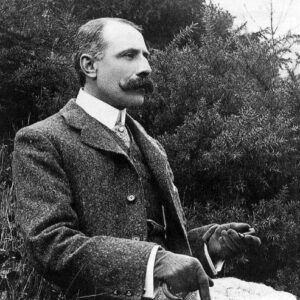 Edward Elgar (1857-1934)
Edward Elgar (1857-1934)
Variation IX: “Nimrod,” from Enigma Variations, Op. 36 (1899)
In 1899, the British composer Edward Elgar wrote a series of variations on a theme, each dedicated to a close friend. Elgar later wrote:
This work, commenced in a spirit of humour & continued in deep seriousness, contains sketches of the composer’s friends. It may be understood that these personages comment or reflect on the original theme & each one attempts a solution of the Enigma, for so the theme is called. The sketches are not ‘portraits,’ but each variation contains a distinct idea founded on some particular personality or perhaps on some incident known only to two people. This is the basis of the composition, but the work may be listened to as a ‘piece of music’ apart from any extraneous consideration.
Many scholars believe the “Enigma” refers to some hidden melody, but so far, no one has come up with a convincing “solution” to the puzzle.
The ninth variation, “Nimrod,” is by far the most popular of the fourteen different portraits in the piece. It refers to Elgar’s friend August Jaeger, a music editor at the London publishing firm Novello & Co. (Jaeger, or Jäger, is the German word for “hunter.” Nimrod is an Old-Testament character described as a mighty hunter.)
Elgar explained later that this movement was not meant to be a portrait of Jaeger, the man, but instead is a reaction to something that happened between the two. Elgar had at one point been distraught and considered giving up composition entirely. Jaeger visited him and encouraged Elgar to keep going. Jaeger reminded him of Beethoven’s lifelong struggles with his deafness and contemplation of suicide but pointed out that Beethoven continued composing exquisite music and sang the melody of the second movement of Beethoven’s Pathétique piano sonata. Elgar confesses that the opening bars of “Nimrod” suggest the Beethoven theme: “Only a hint, not a quotation.”
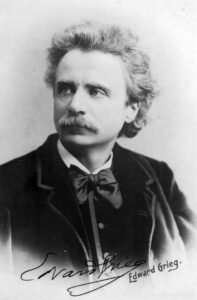 Edvard Grieg (1843-1907)
Edvard Grieg (1843-1907)
Movement IV, “Solveig’s Song” from Peer Gynt Suite #2, Op. 23 (1875)
Edvard Grieg–Norway’s most renowned composer, was asked by Henrik Ibsen–Norway’s most renowned playwright, in 1874 to compose incidental music to Ibsen’s play Peer Gynt. The play, in five acts, describes the journey of its protagonist, Peer Gynt, from Norway to the North African desert. Grieg’s music is intended as introductions to scenes, sometimes as background music, and sometimes contains songs to be sung by the actors. The full score for the entire set of incidental pieces had been lost until the 1980s, and the complete incidental music for the play had rarely been performed in Grieg’s lifetime. But in 1885, Grieg extracted eight short movements from Peer Gynt and arranged them into two suites. The “Morning Mood” and “In the Hall of the Mountain King” from the first suite are not only two of Grieg’s most popular compositions but two of the most recognizable pieces in the entire orchestral repertoire. “Solveig’s Song” is the last of the four movements in the second suite.
Solveig, in the play, is the eldest daughter of a family he meets on his journey. She eventually joins him and becomes his companion and lover. Toward the end of the play, Peer despairs that he has lived a worthless life and will die a sinner. Solveig sings this comforting lullaby to him with the words, “You have not sinned at all, my dearest boy.”
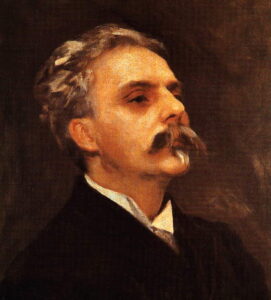 Gabriel Fauré (1845-1924)
Gabriel Fauré (1845-1924)
“Agnus Dei” and “In Paradisum” from Requiem in D minor, op. 48 (1890)
French composer Gabriel Faure’s legacy is probably best exemplified through his students’ success as the head of the Paris Conservatoire, Maurice Ravel, and Nadia Boulanger chief among them. Fauré was caught in the middle of changing times—the end of the Romantic era of composition and the beginning of the Modernist as Europe, and Paris in particular, was turning over a new century and spiraling toward the Great War. Fauré’s music was seen as too revolutionary and modern by the old-guard of romanticists and too quaint and gentle by the avant-garde of modernists.
Fauré’s Requiem is likely his most well-known work—or perhaps his Pelleas et Melisande. But in any case, the Requiem, like Fauré’s career and oeuvre, doesn’t fit any standard molds. He composed the work over several years from the mid-1880s, revising it in the 1890s, and finally completing it in 1900. Fauré’s Requiem does not follow the traditional Latin liturgy of a requiem funeral mass. Instead, it’s a calmer, gentler setting of the texts that Fauré found most comforting. In particular, Fauré leaves out the Dies irae (Day of Wrath) portion and replaces it with only the Pie Jesu lines, translating to “Pious Jesus, Give them rest. Pious Jesus, Give them everlasting rest.” As Fauré later said:
It has been said that my Requiem does not express the fear of death and someone has called it a lullaby of death. But it is thus that I see death: as a happy deliverance, an aspiration towards happiness above, rather than as a painful experience. The music of Gounod has been criticised for its inclination towards human tenderness. But his nature predisposed him to feel this way: religious emotion took this form inside him. Is it not necessary to accept the artist’s nature? As to my Requiem, perhaps I have also instinctively sought to escape from what is thought right and proper, after all the years of accompanying burial services on the organ! I know it all by heart. I wanted to write something different.
The Requiem was performed at Fauré’s funeral in 1924.
Texts of the “Agnus Dei” and “In Paradisum” movements:
Agnus Dei
| Agnus Dei, qui tollis peccata mundi dona eis Requiem |
O Lamb of God, that takest away the sin of the world, grant them rest |
| Lux aeterna luceat eis, Domine Cum sanctis tuis in aeternum, quia pius es |
May eternal light shine on them, o Lord, with Thy saints forever, because Thou are merciful. |
| Requiem aeternam dona eis Domine, et lux perpetua luceat eis |
Grant them eternal rest, o Lord, and may perpetual light shine on them. |
In Paradisum
| In Paradisum deducant Angeli in two adventu suscipiant te Martyres et perducant te in civitatem sanctam Jerusalem |
May the angels receive them in Paradise, at the coming may the martyrs receive thee and bring thee into the holy city Jerusalem |
| Chorus Angelorum te suscipiat et cum Lazaro quondam paupere aeternam habeas requiem |
There may the chorus of angels receive thee, and with Lazarus, once a beggar, may thou have eternal rest. |
| Aeternam habeas requiem | May thou have eternal rest. |
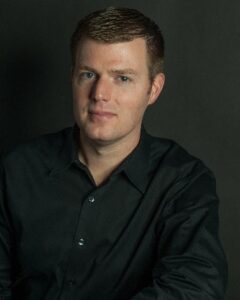 Dan Forrest (b. 1978)
Dan Forrest (b. 1978)
i thank You God for most this amazing day (2018)
Dan Forrest has been described as having “an undoubted gift for writing beautiful music….that is truly magical” (NY Concert Review), with works hailed as “magnificent, very cleverly constructed sound sculpture” (Classical Voice), and “superb writing…full of spine-tingling moments” (Salt Lake Tribune). In the last decade, Dan’s music has become well established in the repertoire of choirs in the US and abroad, through both smaller works and his major works Requiem for the Living (2013), Jubilate Deo (2016), and LUX: The Dawn From On High (2018). Dan holds graduate degrees in composition and piano performance, and is active as a composer, educator, publisher, editor, and pianist.
Forrest’s i thank You God for most this amazing day was commissioned and premiered by the Atlanta Master Chorale in 2018. It uses the text of e.e. cumming’s poem by the same title:
i thank You God for most this amazing
day: for the leaping greenly spirits of trees
and a blue true dream of sky; and for everything
which is natural which is infinite which is yes
(i who have died am alive again today,
and this is the sun’s birthday; this is the birth
day of life and of love and wings: and of the gay
great happening illimitably earth)
how should tasting touching hearing seeing
breathing any—lifted from the no
of all nothing—human merely being
doubt unimaginable You?
(now the ears of my ears awake and
now the eyes of my eyes are opened)
Guest Conductor
Edith A. Copley is a Regents’ Professor and Director of Choral Studies at Northern Arizona University in Flagstaff. She conducts the highly acclaimed Shrine of the Ages Choir (founded in 1933) and teaches undergraduate and graduate courses in conducting and graduate choral literature. The Shrine of the Ages Choir has performed at state, regional and national conferences of the American Choral Directors Association and the National Association for Music Education, and Carnegie Hall. NAU choral ensembles under her direction have toured internationally to Western Europe, the Peoples Republic of China, Australia, New Zealand, South Africa, Bulgaria, Istanbul, Sweden, Estonia, and Latvia performing in many beautiful and historic venues.
In spring 2016, Dr. Copley retired as Music Director of the Master Chorale of Flagstaff (MCF). She led this auditioned 100-voice community chorus for 23 years. MCF performed three concerts each season as well as a major choral/orchestral work each spring with the Flagstaff Symphony Orchestra (FSO). Copley has conducted numerous major works with the FSO, including Brahms’s Ein Deutsches Requiem, Orff’s Carmina Burana, Bach’s B Minor Mass, Mozart’s Mass in C Minor, Duruflé’s Requiem and Britten’s War Requiem. In 1999 she served as the Resident Conductor for the FSO’s 50th Anniversary Season.
Conductor & Musical Director – Charles Latshaw
Guest Conductor – Edith A. Copley
Shrine of the Ages Choir
Video – Nicholas Geib, Firewatch Media
Audio – Kyle Miller, Lore Audio
Graphics – Heather Brown, Cultural Sponge
Executive Producer – Larry Lang, Flagstaff Symphony Orchestra
View Our Season Program